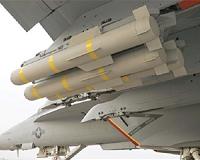| . |  |
. |
USS Carl Vinson, At Sea (SPX) Jul 29, 2010 USS Carl Vinson (CVN 70) uploaded and launched Evolved Sea Sparrow Surface Missiles (ESSM) and Rolling Airframe Missiles (RAM) July 16 and 17 to support Combat Systems Ship's Qualification Trials (CSSQT). This is the first time Vinson has had missiles on board since the completion of a five-year refueling complex overhaul. "It's part of the qualifications for Combat Systems to test its equipment and abilities underway," said Lt. Cmdr. Michael Bornstein, Vinson's ordnance handling officer. These qualifications indicate that the ship is ready to defend itself from attack. The ESSM weighs approximately 590 pounds, while the RAM is a lightweight 200-pound missile. Both are quick-reaction, fire-and-forget missiles designed to destroy both incoming anti-ship missiles as well as asymmetric air and surface threats. They are used for air-to-air defense, always ready to be launched toward any enemy force. "These guys have never done this before, so there has been a lot of training for the junior personnel to prepare them for this operation," said Fire Controlman 2nd Class James (SW/AW) Worley, the ship's Combat Systems assistant leading petty officer. "They are all very excited." "I love my job and my experience here so far," said Fire Controlman Fireman Kevin Van Gorder. "I'm excited. This is what we train for. We train like we fight, we fight like we train. This is what it's all about, our sole purpose as fire controlmen is to defend the ship." This was the first time in four years that Combat Systems and Weapons departments worked together. "It was fairly easy to accomplish the movement of the missiles," said Aviation Ordnanceman 1st Class (AW/SW) Joshua Shryock, Weapons Department's G-3 Division leading petty officer. "Combat Systems dictated ordnance control while Weapons department physically moved the missiles." After Weapons department personnel loaded the missiles on July 16, Combat Systems launched the missiles the following day. "We did a lot of work for our ship to be functional now," said Fire Controlman 1st Class (SW/PJ) Eric McQuitty. "Launching these missiles gives us more purpose to do our job everyday because we feel more prepared and motivated." "Most Sailors don't have the opportunity to shoot this many missiles in their entire career, and we are going to do it within a week period," said Chief Fire Controlman (SW/AW) Derek Besand, Combat System's CS-7 Division leading chief petty officer. "Launching missiles shows our ship, the Navy, and the world that Vinson is ready for combat." "We successfully shot three missiles; one RAM and two ESSMs. We passed our qualifications and certifications for the ship's self-defense system, which demonstrates that Carl Vinson can defend itself from any attack," said Worley. "It felt awesome. We put in a lot of long hours and a lot of hard work, and it paid off. All eyes were on us, and we delivered."
Share This Article With Planet Earth
Related Links US Navy Learn about missile defense at SpaceWar.com All about missiles at SpaceWar.com
 Raytheon-Boeing Team On Target During First Government-Funded Test Of JAGM
Raytheon-Boeing Team On Target During First Government-Funded Test Of JAGMWhite Sands Missile Range NM (SPX) Jul 27, 2010 Raytheon and Boeing have completed the first of three government-sponsored firings of the Joint Air-to-Ground Missile. During the successful test, the JAGM used its laser guidance system to hit an 8-by-8-foot target board from a distance of 16 kilometers (10 miles). The Raytheon-Boeing JAGM features a tri-mode seeker with laser; an uncooled imaging infrared sensor; and millimeter wave guid ... read more |
|
| The content herein, unless otherwise known to be public domain, are Copyright 1995-2010 - SpaceDaily. AFP and UPI Wire Stories are copyright Agence France-Presse and United Press International. ESA Portal Reports are copyright European Space Agency. All NASA sourced material is public domain. Additional copyrights may apply in whole or part to other bona fide parties. Advertising does not imply endorsement,agreement or approval of any opinions, statements or information provided by SpaceDaily on any Web page published or hosted by SpaceDaily. Privacy Statement |